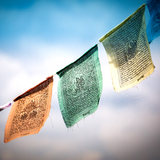
Tibetan prayer flags are used used to bless the surrounding countryside and for other purposes. Prayer flags are believed to have originated with Bon. In Bon, shamanistic Bonpo used primary-colored plain flags in Tibet. Traditional prayer flags include woodblock-printed text and images. Legend ascribes the origin of the prayer flag to Gautama Buddha, whose prayers were written on battle flags used by the devas against their adversaries, the asuras.
Traditionally, prayer flags come in sets of five: one in each of the five colours that correspond with the 5 Elements of Chinese theory. The five colors are arranged from left to right in a specific order: blue, white, red, green, and yellow. The five colors represent the five elements and the Five Pure Lights. Different elements are associated with different colors for specific traditions, purposes and sadhana. Blue symbolizes the sky and space, white symbolizes the air and wind, red symbolizes fire, green symbolizes water, and yellow symbolizes earth. According to Traditional Tibetan medicine, health and harmony are produced through the balance of the five elements.
In addition to mantras, prayers for a long life of good fortune are often included for the person who mounts the flags.
Images or the names of four powerful animals, also known as the Four Dignities, adorn each corner of a flag: the dragon, the garuda, the tiger, and the snowlion. The prayer tag OM MANI PADME HUM refers to OM which symbolizes your impure body speech and mind. MANI meaning jewel, symbolizes the factors of method—the altruistic intention to become enlightened, compassion, and love. PADME meaning lotus, symbolize wisdom. HUM is the seed syllable of Akshobhya—the immovable, the unfluctuating, that which cannot be disturbed by anything.
Traditionally, prayer flags are used to promote peace, compassion, strength, and wisdom. The flags do not carry prayers to gods, which is a common misconception; rather, the Tibetans believe the prayers and mantras will be blown by the wind to spread the good will and compassion into all pervading space. Therefore, prayer flags are thought to bring benefit to all.
By hanging flags in high places the Lung ta will carry the blessings depicted on the flags to all beings. As wind passes over the surface of the flags, which are sensitive to the slightest movement of the wind, the air is purified and sanctified by the mantras.
The prayers of a flag become a permanent part of the universe as the images fade from exposure to the elements. Just as life moves on and is replaced by new life, Tibetans renew their hopes for the world by continually mounting new flags alongside the old. This act symbolizes a welcoming of life's changes and an acknowledgment that all beings are part of a greater ongoing cycle.
According to traditional belief, because the symbols and mantras on prayer flags are sacred, they should be treated with respect. They should not be placed on the ground or used on clothing. Old prayer flags should be burned.
藏族祈禱旗被用來祝福周圍的鄉村和其他目的。傳統的祈禱旗包括木塊印刷的文本和圖像。傳說祈禱旗的起源歸因於高塔瑪佛陀,其祈禱寫在戰鬥旗上。 德瓦斯 對他們的對手, 阿蘇拉斯.





